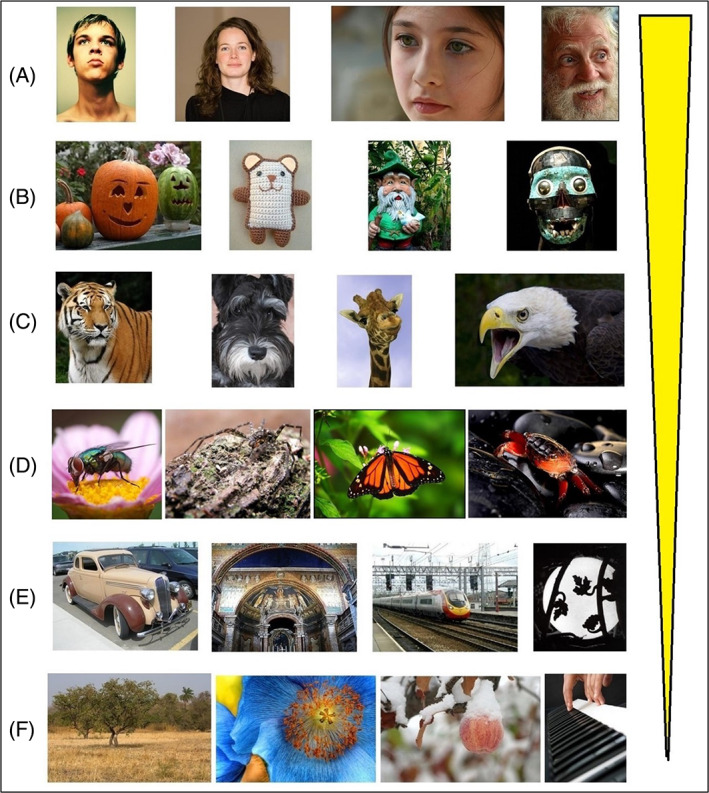Human faces and face-like stimuli are more memorable.
IF 1.3
4区 心理学
Q3 PSYCHOLOGY, MULTIDISCIPLINARY
引用次数: 2
Abstract
Abstract We have previously suggested a distinction in the brain processes governing biological and artifactual stimuli. One of the best examples of the biological category consists of human faces, the perception of which appears to be determined by inherited mechanisms or ones rapidly acquired after birth. In extending this work, we inquire here whether there is a higher memorability for images of human faces and whether memorability declines with increasing departure from human faces; if so, the implication would add to the growing evidence of differences in the processing of biological versus artifactual stimuli. To do so, we used images and memorability scores from a large data set of 58,741 images to compare the relative memorability of the following image categories: real human faces versus buildings, and extending this to a comparison of real human faces with five image categories that differ in their grade of resemblance to a real human face. Our findings show that, in general, when we compare the biological category of faces to the artifactual category of buildings, the former is more memorable. Furthermore, there is a gradient in which the more an image resembles a real human face the more memorable it is. Thus, the previously identified differences in biological and artifactual images extend to the field of memory.


人脸和类似人脸的刺激更容易被记住。
我们之前已经提出了控制生物和人工刺激的大脑过程的区别。生物类别中最好的例子之一是人脸,对人脸的感知似乎是由遗传机制或出生后迅速获得的机制决定的。在扩展这项工作时,我们在这里询问人脸图像是否有更高的记忆能力,以及记忆能力是否随着与人脸距离的增加而下降;如果是这样的话,这将进一步证明生物和人工刺激处理的差异。为此,我们使用来自58,741张图像的大型数据集的图像和记忆分数来比较以下图像类别的相对记忆性:真实的人脸与建筑物,并将其扩展到真实人脸与五个图像类别的比较,这些图像类别与真实人脸的相似程度不同。我们的研究结果表明,一般来说,当我们将人脸的生物类别与建筑物的人工类别进行比较时,前者更容易被记住。此外,还有一个梯度,即图像越像真人的脸,它就越容易被记住。因此,先前确定的生物和人工图像的差异延伸到记忆领域。
本文章由计算机程序翻译,如有差异,请以英文原文为准。
求助全文
约1分钟内获得全文
求助全文
来源期刊

PsyCh journal
PSYCHOLOGY, MULTIDISCIPLINARY-
CiteScore
2.70
自引率
12.50%
发文量
109
期刊介绍:
PsyCh Journal, China''s first international psychology journal, publishes peer‑reviewed research articles, research reports and integrated research reviews spanning the entire spectrum of scientific psychology and its applications. PsyCh Journal is the flagship journal of the Institute of Psychology, Chinese Academy of Sciences – the only national psychology research institute in China – and reflects the high research standards of the nation. Launched in 2012, PsyCh Journal is devoted to the publication of advanced research exploring basic mechanisms of the human mind and behavior, and delivering scientific knowledge to enhance understanding of culture and society. Towards that broader goal, the Journal will provide a forum for academic exchange and a “knowledge bridge” between China and the World by showcasing high-quality, cutting-edge research related to the science and practice of psychology both within and outside of China. PsyCh Journal features original articles of both empirical and theoretical research in scientific psychology and interdisciplinary sciences, across all levels, from molecular, cellular and system, to individual, group and society. The Journal also publishes evaluative and integrative review papers on any significant research contribution in any area of scientific psychology
 求助内容:
求助内容: 应助结果提醒方式:
应助结果提醒方式:


